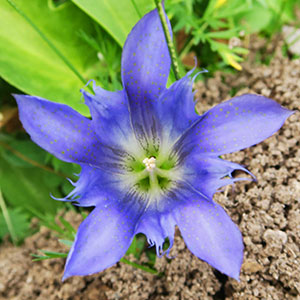Gentiana newberryi
Gentiana parryi
alpine gentian, Newberry's gentian
Parry's gentian
1–5, arising laterally below rosettes, from a stout tap root, tufted, decumbent.
1–7(–14), terminal from caudex, decumbent to erect.
basal and cauline;
blades of basal rosette and proximal cauline leaf blades widely spatulate to obovate or oblanceolate, 0.8–5 cm × 2–25 mm, apex obtuse or mucronate, at least these leaves with blades less than 6 times as long as wide, distal cauline leaves few, with blades oblanceolate to lanceolate or linear, 2–5 cm × 2–5 mm, apices acute.
cauline, ± evenly spaced;
blade ovate, 1.5–4 cm × 8–21 mm, margins not ciliate, apex obtuse;
involucral leaves wider than cauline, ascending and conduplicate, partially enveloping base of inflorescence.
terminal, flowers usually solitary, occasionally 2 or 3.
2–7-flowered heads or occasionally solitary flowers, occasionally with additional flowers in 1 or 2 distal axils.
calyx 14–30 mm, lobes linear to narrowly ovate, (4–)6–12 mm, margins not ciliate;
corolla white or blue, campanulate, open, 23–55 mm, lobes spreading, elliptic-obovate, 7–17 mm, free portions of plicae divided into 2 triangular, serrate to lacerate segments;
anthers distinct.
calyx 10–20(–27) mm, lobes linear to lanceolate, (1–)4–8 mm;
corolla deep blue or violet-blue, campanulate, open, 33–50 mm, lobes spreading, obovate, 4–9 mm, free portions of plicae divided less than 1/2 their length into 2–5 triangular segments threadlike only toward apex;
anthers distinct.
winged.
not winged.
Gentiana newberryi
Gentiana parryi
Varieties 2 (2 in the flora).
The two varieties of Gentiana newberryi intergrade extensively. The most distinctive form of var. newberryi, with relatively tall stems and medium to deep blue corollas, occurs in the northern part of the range of the species, from the Klamath and White mountains of California north into Oregon. Plants most clearly referable to var. tiogana prevail in the southern part of the range of the species, from Butte County south to Inyo and Tulare counties, California. In the central part of the range of the species, plant size and corolla color are less consistently correlated, with occasional plants combining low stature with deep blue corollas or tall stems with predominantly white or pale blue corollas. In that part of the range, corolla color may be highly variable within a single population.
The leaves of Gentiana newberryi are thick-textured and distinctively concave, usually spoon-shaped, when fresh. Narrower leaves sometimes occur in var. tiogana, but many plants of that variety have widely spatulate leaves like those of var. newberryi.
(Discussion copyrighted by Flora of North America; reprinted with permission.)
Reports of Gentiana parryi outside the range indicated here have been based on specimens of G. calycosa or G. affinis (studies for this flora). Because of its restriction to high altitudes, populations of G. parryi are widely scattered, especially in the southern part of its range.
Gentiana parryi has sometimes been included in G. calycosa and less often in G. affinis, but its larger, conduplicate involucral leaves, which are more or less sharply differentiated from the distal cauline leaves and largely envelop the calyces, give G. parryi an aspect distinctly different from that of either G. calycosa or G. affinis. Biometric studies by J. R. Spence (unpubl.) have supported its recognition as a species. As noted by N. H. Holmgren (1984b), these species also differ in anther length, which is 3.5–5 mm in G. parryi and 1.6–3.2 mm in G. calycosa and G. affinis. In the Rocky Mountains of central Colorado, G. parryi and G. affinis appear especially well differentiated. Where the ranges of G. parryi and G. calycosa approach each other in the Intermountain Region, G. parryi usually grows in drier habitats than G. calycosa. The distinctive involucre of G. parryi is less well developed in some Arizona plants otherwise identifiable as this species, which should be given further study.
(Discussion copyrighted by Flora of North America; reprinted with permission.)
1. Corollas medium to deep blue with greenish to dark purple lines abaxially on and below lobes, usually 35–55 mm. | var. newberryi |
1. Corollas white to pale blue except for greenish to dark purple lines abaxially on and below lobes, usually 23–42 mm. | var. tiogana |


